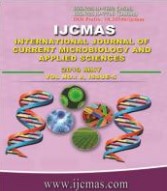


 National Academy of Agricultural Sciences (NAAS)
National Academy of Agricultural Sciences (NAAS)

|
PRINT ISSN : 2319-7692
Online ISSN : 2319-7706 Issues : 12 per year Publisher : Excellent Publishers Email : editorijcmas@gmail.com / submit@ijcmas.com Editor-in-chief: Dr.M.Prakash Index Copernicus ICV 2018: 95.39 NAAS RATING 2020: 5.38 |
The present study was undertaken to evaluate the status of ESBL producing Enterobacteriaceae in foods of animal origin and their environment. A total of 125 samples were collected comprising 95 animal products (40 raw milk, 25 milk products, 15 raw meat and 15 meat products) and 30 environmental samples. The isolation rate was recorded 93.95% in food samples with Citrobacter (38.41%) being the dominant flora, while100% in environmental samples with the dominance of E. coli (89.18%). Of all the ESBL producers, 24.29% were found positive by phenotypic method while 16.38% were found positive by PCR. The phenotypic test revealed highest occurrence of ESBL producers in environmental samples (56.76%) followed by milk (24.44%), meat (16.0%), meat products (15.0%) and milk products (8.00%). Similarly, PCR assay also recorded highest occurrence in the environment (48.65%) followed by raw meat (8.0%) and raw milk (2.0%) samples; however none of the ESBL genes was detected in milk and meat products. ESBL genes positive isolates belonged to the genera Escherichia, Klebsiella and Citrobacter. The frequency of blaCTX, blaSHV and blaTEM genes in E. coli isolates was 37.97%, 6.89% and 3.44%, respectively. The co-existence of blaCTX and blaTEM, blaSHV and blaTEM and blaCTX and blaSHV, was found 17.24%, 6.89% and 3.44% in E. coli isolates, respectively. Citrobacter isolates harboured single (blaCTX 3.44%) as well as multiple genes (blaCTX +blaSHV 3.44%) and (blaCTX+blaTEM 6.89%) while Klebsiella isolates showed only blaCTX gene (6.89%). Only one E. coli isolate (3.44%) in the present study harboured all three genes.
 |
 |
 |
 |
 |